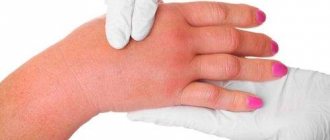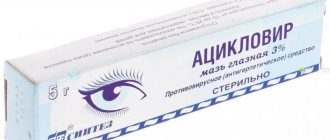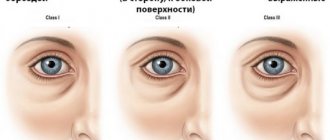How and with what to remove swelling after a bruise
A bruise is a consequence of a blow with a blunt object or the result of an unsuccessful fall. The injury is accompanied by the appearance of a hematoma, and is always accompanied by painful sensations. Another obligatory sign is swelling of the damaged area , and the greater the swelling, the stronger the pain. At home, you can relieve swelling with the help of medications, as well as traditional medicine recipes that have been proven for centuries.
Photo 1. Swelling adds pain to the bruise. Source: Flickr (jehs_enfraloca).
Swelling of lips and eyes
No part of the human body compares to the face in sensitivity.
Many of us would be prepared to receive a much more serious bruise on another part of the body, just not on the face. Even a minor hematoma and swelling on the face can drive a person into an awkward situation and give rise to many questions. What to do if the blow hits your lips or eyes? A blow to the lip is often accompanied by damage. The skin of the lips is very delicate and thin, so it bursts quickly. In addition, the capillaries on the lips are located close to the skin, so such hematomas are more obvious and larger. If you receive a blow to your lip, you should try to disinfect the wound as quickly as possible. After this, ice is applied to the site of the bruise, placed in a bag and wrapped in cloth. The bruise site should be lubricated with wound-healing ointments. Use sea buckthorn or almond oil - they will moisturize the skin of your lips and help relieve swelling.
If a blow hits the area around the eyes, you need to be very careful. After all, the eyes are a sensitive organ that can also be damaged by a blow. It is best to consult a doctor after the incident. He will check the condition of the lens and retina of the eye. A visit to the doctor should be mandatory if you notice deterioration in your vision after the impact.
Dizziness, deterioration in general health, nausea, loss of consciousness - this is a reason to immediately consult a doctor. If the person’s general condition remains unchanged, swelling after an impact can be treated at home. Usually the hematoma and swelling go away in about two weeks. With our tips, you can cut your healing time in half.
how to relieve swelling after a broken arm
Signs of bruise
A sufficiently strong mechanical impact leads to injury to soft tissues. Only minor abrasions may appear on the skin, the bones remain intact, but the blood vessels, lymphatic vessels and muscle fibers are torn.
A bruise can be identified by its characteristic signs:
- Aching pain of varying degrees of intensity. The smaller the area of damage, the less pronounced the pain.
- Redness of the skin and increased temperature at the site of impact.
- The appearance of hematomas and bruises due to subcutaneous hemorrhage.
- Edema is a consequence of tissue infiltration with lymph and blood from ruptured vessels.
Note! If the swelling is massive, the pain will be quite intense, and the movements of the injured limb will be limited. There may be numbness in the injured part of the body.
Causes of bruise and swelling
The reason why a bruise occurs is a strong blow as a result of a fall or impact with a blunt object.
You can get such an injury by getting into an accident, playing sports, falling, getting into a fight, or hitting something. In this case, soft tissues and vessels - lymphatic and blood vessels - are damaged. It is from the rupture that leads to the development of edema.
Lymph and blood flow into the tissue, accumulating under the skin and causing characteristic swelling.
The larger and deeper the damage, the more massive and painful the swelling. Pain is the result of compression of nerve endings by swollen tissues, so increasing swelling is accompanied by increased pain .
Elimination of this phenomenon is one of the main tasks of subsequent treatment.
Ways to relieve swelling from a bruise
You can reduce swelling and prevent its worsening even at the first aid stage:
- The victim, first of all, needs to be kept at rest , since movement accelerates bleeding and the release of lymph from ruptured vessels.
- Then be sure to apply something cold to the injured area. The best option is a bag filled with ice, but a heating pad with cold water or just a wet towel will also work. Cold causes blood vessels to contract and, accordingly, reduce the volume of fluid coming out of them.
- For the same purpose, a tight bandage . Thus, the tissues are compressed, closing the lumen of the blood vessels.
Medication treatment at home
If the injury does not require surgical intervention, there are no fractures or dislocations, then the bruise is treated at home.
It is imperative to remain calm and continue to apply cold , and only after three days warm the limb with baths and compresses (this will dissolve the infiltrate in the tissues faster).
To relieve swelling, various pharmaceutical drugs are prescribed for topical use or oral administration:
- NSAIDs for oral use - Indomethacin or Diclofenac tablets, one three times a day. They help reduce inflammation and swelling while providing pain relief.
- The same non-steroidal anti-inflammatory drugs, but in the form of ointments and gels. You need to apply them to the damaged area 3 or 4 times a day.
- External agents with heparin also help relieve swelling - heparin ointment, Lyoton, Venolife.
- Creams and gels with troxerutin improve microcirculation and reduce swelling - Troxevasin, Troxegel, Troxerutin. Like drugs with heparin, they are applied 3-4 times daily.
It is important! You can use medications only according to your doctor’s recommendations. The products have contraindications and can cause allergies, so self-medication is unacceptable.
Folk remedies for relieving swelling
Time-tested folk remedies also give good results. You should not take any homemade medicines internally, but the following effective and safe methods for relieving swelling are recommended locally:
- cabbage leaves for several hours . You need to secure it with a bandage and regularly change it to a new one as it dries.
- Grated raw potatoes also give excellent results. Used as a compress at night: the mass is placed in gauze, applied, insulated on top with cellophane or cling film, then covered with a bandage.
- Salt or vinegar compresses are made in almost the same way, only instead of gauze with potatoes, a cloth soaked in a solution (a tablespoon of apple cider vinegar or salt per liter of water) is applied for half an hour.
- If you are not allergic to bee products , you can make a two-hour honey-beet compress every day. Grate small raw beets, add a spoonful of honey, and apply in the same way as potatoes.
- Fresh aloe, burdock or plantain
- You can brew dry herbs (St. John's wort, chamomile, calendula, coltsfoot) and make lotions. The decoction is prepared for 10 minutes over low heat from a tablespoon of raw materials and a glass of water, used after cooling and straining.
Note! If compresses and lotions do not help get rid of swelling within a few days, you should consult a traumatologist. Most likely, not only soft tissues are damaged, but also bones or ligaments.
How to remove a tumor from your hand, what to use at home
You can remove a tumor from your hand at home using:
- Curd compress. The product is placed in 1 layer of gauze and applied for 30-40 minutes. If you do this immediately after getting a bruise, you must first put the cottage cheese in the freezer so that the product is cold. In the future, you can apply it simply by taking it from the refrigerator and without fear of heating.
- Cabbage leaf or plantain. One of the products is thoroughly washed and damaged with a knife so that the juice comes to the surface. The leaf is tied to the sore spot for several hours until it dries. Then a new compress is made.
- Dry mustard. It is best to make appliqués with it. The product is mixed with water to a paste consistency and applied to the skin for a few minutes. Mustard provides a rush of blood to the surface, as a result of which restoration processes in damaged tissues are accelerated.
At home, you can use Diclofenac and Fastum gels, which relieve pain and inflammation. One of the conditions for successful treatment is reducing the load on the injured limb - arm or leg.
Compress on the leg
A compress on the leg can be made from means available to everyone:
- Sea or regular table salt. You need to mix a strong solution and cool it to a comfortable temperature. A napkin is moistened in the liquid and fixed at the site of injury for 15-20 minutes. Can be repeated 3 times a day.
- Cheremshi. The leaves of the plant are crushed, applied to the bruise and covered with a piece of food-grade polyethylene, and on top with a gauze bandage. The compress can be left overnight, then the pain from the bruise will decrease and it will be possible to prevent the appearance of a bruise.
- Wormwood. The plant also needs to be crushed so that the juice comes into contact with the skin. To remove swelling after an injury, the product is placed in a gauze bag and tied to the sore spot. You should keep it for 30 minutes 2 times a day, the second time is better before bedtime.
External remedies from the pharmacy Deep Relief, Nise, Ortofen accelerate healing. The leg needs rest during treatment. That is, you should rest more and at the same time place the limb on a flat surface so that the blood does not rush down, causing additional swelling and pain.
From your finger
You can relieve swelling from your finger after a bruise using:
- Reparil-gel based on diethylamine salicylate and escin. The product is applied to the skin, without rubbing, several times a day. It strengthens blood vessels, has an analgesic effect, and promotes the natural removal of fluid.
- Dolgit cream, the main component of which is ibuprofen. The product relieves pain well and stops the inflammatory process. Dolgit has a particularly beneficial effect on joints, which often suffer from bruised fingers. It is applied 2-3 times a day.
- Capsicum ointment. It contains dimethyl sulfoxide, camphor and turpentine, therefore it has a vasodilating, warming and local irritant effect. This reduces pain and accelerates tissue regeneration. You can use Capsicam 3 times a day.
It is advisable to immobilize the injured finger, that is, bandage it. And if he is on his feet, he needs spacious, comfortable shoes and a reduction in the load.
Ways to speed up recovery
In order for the bruise to go away faster and swelling to disappear, you need to adhere to medical recommendations and fulfill the following requirements:
- Ensure rest of the damaged area - limit physical activity, especially in the first few days. For the same purpose, you should wear an elastic bandage or special fixing devices - bandages, orthoses.
- Apply cold regularly during the first 24 hours (for 15-20 minutes every hour), and then heat the bruise so that the swelling resolves faster. Daily hot baths, water or alcohol compresses, as well as some physiotherapy (IR irradiation) provide a good warming effect.
- Daily self-massage also helps to resolve the infiltrate , especially with the use of warming ointments (camphor, turpentine).
As practice shows, disciplined patients who follow all instructions and take prescribed medications recover quickly, without complications.
First aid
If swelling begins to develop on an arm or leg after a bruise, it is necessary to provide yourself or another victim with first aid. Applying cold to the area where the injury occurred will help relieve swelling after a bruise. To do this you can use:
- Cold heating pad;
- Plastic bottle with cold water;
- Ice;
- Frozen foods.
In addition to local effects, you can fight swelling with non-steroidal anti-inflammatory drugs. These can be either oral medications or cooling ointments or creams. Such actions will help not only get rid of swelling, but also reduce pain, and also prevent the development of a large hematoma.
Swelling from a bruise quickly goes away if a pressure bandage is applied to the injury site. Due to pressure, the flow of fluid to the injured limb is reduced. Heating a bruise in the first two or three days after receiving an injury is prohibited, as this will make the swelling take longer to go away.
Immediately after the injury
Prompt action immediately after an injury is the key to the absence of consequences. If you start acting right away, you won’t have to think and wonder later how to disguise the bruise and swelling. So what should you do immediately after the impact?
- The best solution is to apply ice to the injury site. It is best to wrap it in a small piece of cloth to prevent frostbite. The fact is that immediately after the blow, the nerve endings work at their limit and you may simply not feel the excess cold. Wrap a piece of ice or frozen meat in a handkerchief and apply it to the bruise. If the injury occurred outside the home, you can apply snow to the wound. During the warm season, run to the nearest store and apply a glass bottle of cold drink to the injury site.
- A few minutes after applying ice, you can prepare an herbal compress. To do this, take plantain, wormwood, St. John's wort or yarrow. The best option is to quickly use a ready-made decoction, but you don’t always know when you might need it. Therefore, for the first time after an injury, keep ice at the site of the injury and prepare a decoction for a compress. Pour boiling water over the medicinal herbs and let it brew. After this, cool the broth as much as possible. The compress must be cold - heat can only aggravate the problem. Soak a piece of sterile bandage in a cold medicinal decoction and apply it to the bruise. As the compress warms up, change the bandage to a cooler one. After a half-hour compress, the swelling usually subsides.
- Since you may not have the herbs you need on hand, use plain black tea. Soak a piece of cloth or a cotton pad in it and apply it to the impact site. The liquid must also be cold.
- You can cure fresh and old swelling with onion juice. Grate the onion and squeeze the juice out of it. Soak a cotton pad in the juice and apply to the bruised area of skin. Onion juice irritates the skin and increases blood circulation, which allows swelling to resolve more quickly.
- You can relieve swelling and prevent the appearance of hematoma using vinegar. Make sure the vinegar is no more than 10%, otherwise you may burn your skin. Vinegar should also not be applied if there are open wounds or damage to the skin.
- Fermented milk products - kefir, fermented baked milk, cottage cheese - help very well. A special convenience is that dairy products are always in the refrigerator, which means they are always ready to help. Apply a piece of cold cottage cheese to the site of the blow, and there will be no trace of slight swelling left.
All these remedies are relevant only after an immediate response - if you apply a compress in the first minutes after the blow. In other cases, they are practically useless.
how to relieve swelling after tooth extraction
Relieving swelling in different parts of the body
Despite the main ways in which swelling can be removed from a bruise, there are different methods for damage to different parts of the body. This is due to the fact that blood circulation and fluid outflow in the limbs and, for example, on the face, occur differently.
So, you need to know how to remove the swelling in case of a bruise:
- Shins. Injuries to this part of the leg are especially painful because there are many pain receptors here. If swelling occurs on the lower leg, then without treatment it does not go away for a long time and becomes even larger. Treatment consists of extremity elevation, cold compresses, and cooling agents.
- Feet. The bones of the foot are small and can break during injury. If severe swelling is present, it is best to take an x-ray. In the absence of a fracture, cold compresses in the first two days and ointments with a warming effect in the following days will help relieve swelling.
- Fingers. If your fingers are bruised, all rings are removed; if your toe is injured, you should avoid tight shoes. Apply cold to the injury site, and from the third day apply warming preparations to the injury.
- Brushes. The first step is to remove your bracelets and watches, and then cool the injury site. It is better to hang the limb on a scarf so that a large amount of blood and fluid does not flow to it.
- Faces. Bruises on the face are the most unpleasant, as they cannot be hidden under clothing. Few people want to walk around with a swollen face, so it is important for everyone to know how to treat their face so that the consequences of the bruise go away faster. Immediately after receiving an injury, you should apply something cold to the bruise, and then use Troxavesin or Traumeel ointments. They should be alternated every two to three hours. If, in addition to swelling, there is a hematoma, then you can lubricate it with Bruise-Off.
What to do immediately after an impact to avoid swelling of the face
To prevent swelling of the face, it is necessary to provide first aid in a timely manner. A few ice cubes may be needed. It is necessary to use something cold after the blow. When there is no ice, ice cream and even dumplings will do.
Cold objects will prevent blood and lymph from accumulating, since the cold will help slightly narrow the nearby vessels. This method only helps in the first 25 minutes.
When about half an hour has passed since the impact, you need to use the following methods:
- Herbal compress. Herbs (wormwood, calendula, St. John's wort and everyone's favorite in childhood, plantain) help best with swelling. Based on them, a decoction is prepared, which must be used cold.
- Black tea. It must be strong, then the tea will work. Application of a cotton pad soaked in tea to the face should be continued for at least 1 day.
- Onion juice. It helps if there are already bruises and swelling on the face.
- Table vinegar. 9% vinegar is best. Do not use this method if there are wounds on the skin.
- Homemade kefir. It can be replaced with fermented baked milk or homemade cottage cheese.
Traditional methods
It often happens that a bruise occurs at a time when there are no special medications in the home medicine cabinet, and the pharmacy is already closed. A person can generally be outside the city, on vacation, in the country, where there are no pharmacies. In this case, traditional medicine methods will help to cope with swelling and other symptoms of a bruise.
From time immemorial, our ancestors used the following recipes:
- After use, the tea leaves are cooled, wrapped in a piece of gauze and applied to the site of swelling.
- The onion is grated, the pulp is wrapped in gauze and applied to the bruise. Onion reduces swelling and pain.
- Make a cottage cheese cake, place it on a piece of cloth and place it in the freezer for about five minutes. Cottage cheese remains cold for a long time and helps not only reduce swelling, but also eliminate hematoma.
- They grind various plants and apply them to the bruise. Among the most effective are St. John's wort, plantain leaves, and wild garlic. The juice of these herbs has a beneficial effect on soft tissues, has an antiseptic effect, and improves blood circulation and fluid outflow at the site of injury.
Medicinal plants can be used either in raw chopped form or brewed for compresses, made into tinctures, powders, and ointments. Another effective way is to use a lotion of a pinch of salt, a couple of drops of iodine, a tablespoon of vinegar and a tablespoon of water. A bandage soaked in this liquid is applied to the bruise, and the top is covered with a plastic bag and bandaged with a bandage.
Among topical medications for removal, you can use Troxevasin, Mirralgin, Heparin ointment, Bodyaga, Rescuer, or Traumeel. Before using any medicine for a bruise in a child, you should consult a doctor. If very large swelling, impaired motor functionality and hyperemia appear, it is worth undergoing an examination for the presence of fractures or ligament ruptures.
We treat swelling after bruises: with medicines and folk remedies
Bruises are a common type of injury. They differ in origin, area of damage and severity. However, the affected area almost always becomes swollen and swollen. This makes movements difficult.
Victims often wonder how to relieve swelling after receiving a bruise. There is a set of simple tricks and measures to remove or reduce swelling in the damaged area.
First aid
Any cold compress will help quickly relieve swelling after a bruise and reduce pain. It reduces the volume of blood flowing to the injured area, preventing the development of a hematoma.
It is best to remove swelling from a bruise by applying ice, after wrapping it in a clean bag, a cold heating pad or cloth. If you don’t have ice on hand, a rag soaked in ice water will do. In this case, the compress must be cooled regularly.
Iodine mesh, which is applied directly to the area of injury, helps with severe swelling after bruises of a joint of any limb. If the hematoma is very pronounced, doctors advise using a compress with iodine, salt and apple cider vinegar diluted in water.
There are also medications for immediate assistance. First of all, we are talking about products based on natural herbs and oils:
Treatment of various parts of the body
When a tumor is discovered after a bruise, each part of the body requires a special approach. We will look at the most common cases.
The knees are most often affected, especially:
- with an active lifestyle,
- during icy conditions,
- during sports activities.
The usual cooling for such injuries must be carried out in an immobilized position. While indoors, you can lie down with a high pillow under your injured leg. On the street, you can sit on a parapet or on a bench, raising your leg so that your shin is higher than your thigh.
Collagen Ultra helps with knee injuries and the resulting bruises and swelling. This is an effective chondroprotector that reduces swelling and accelerates recovery processes in the affected areas.
In the lower leg, areas adjacent to the bone tissue are often injured. Such damage is considered to be the most dangerous. Here, as on the elbow, pain receptors are located in the periosteum, which in extreme cases even cause pain shock. The swelling around a bruise in this area of the leg grows over time: starting with a small swelling, it later turns into a big problem.
After a cold compress, a special cream, purchased at a pharmacy or made by yourself, will help. If the periosteum of the leg or elbow is bruised, it is best to mix honey with aloe leaf puree. This composition penetrates deeply, relieving swelling.
Foot injuries can lead to fractures of small bones. Having received such an injury, the affected area must be palpated. Feelings of acute pain in at least one point are an indication for an urgent x-ray. To relieve swelling when a foot is bruised, you should apply bandages: first cooling ones, and starting from the second day - warming ones. Pain ointments and rest also help. It is also useful to read about back bruise due to a fall, treatment at home.
If a finger or toe has been bruised, massage it with an ice cube. Next, you will have to avoid straining the finger (from work, tight shoes or long walks). Diabetics should take such injuries especially seriously. They cannot be used to cool injured areas; instead, it is better to use special ointments.
For a slight bruise of the hand, the most commonplace over-the-counter medications will help you avoid bruising and swelling. Sometimes you can get by with folk remedies:
Such remedies act in the format of compresses.
If cold is applied but the pain does not subside within an hour, the chances of a fracture or dislocation increase. A doctor's help is needed.
After a facial injury, swelling often appears under the eyes, around the nose, and on the cheeks. Usually in such cases, Troxevasin and Traumeel ointments, applied in turn at two-hour intervals, help. Gels like Sinyakoff treat and tone the injured area.
In addition, it is important to apply cold to the eyes immediately after injury. Next, potato lotions and bodyagi gel help. Ice wrapped in a scarf or napkin is also usually applied to the lips: not for long, but repeatedly. Ointments will also help in this situation - just not warming ones.
In any case, if the swelling after a bruise does not subside for a long time, contact a doctor. Self-medication in such a situation is fraught with serious complications.
Alternative medicine
In mild cases, swelling from a bruise can be removed at home, without the help of doctors. You can cope on your own using traditional methods. For example, it’s a good idea to steam tea leaves. Then, after squeezing and cooling, apply it regularly to the damaged area in a gauze compress.
Onion juice not only relieves swelling from a bruise, but also reduces pain. Compresses are also made with cottage cheese, which is laid out on thick cloth and then placed in the freezer for a few minutes. Cottage cheese keeps cold for a long time. The lactic acid components it contains:
- relieve swelling,
- remove the bruise
- make the skin lighter.
For a long time, bandages made from crushed plants are applied to the damaged areas - most often, plantain and wild garlic. They relieve pain, swelling, and bruises. In addition to these plants, the following are actively used:
- heather,
- yarrow,
- sagebrush,
- tansy,
- St. John's wort and other herbs.
You can make a whole collection of different plants (preferably all of them). They are poured with a glass of boiled water and left for half an hour. The bandage is soaked in the cooled tincture and applied to the bruise.
A fresh plantain leaf will also do, especially if the injury occurred outdoors. It is cut and applied for a quarter or a third of an hour, then replaced with a new one. An adequate analogue is a cabbage leaf secured with a bandage.
An effective remedy for relieving swelling after a bruise is iodine mesh, especially for the joints of the arms and legs. It will be replaced by apple vinegar, iodine and salt mixed with water. They are applied for a couple of hours with a compress wrapped in polyethylene and then with a bandage.
Do not forget: if the swelling after a bruise does not go away for a long time, you need to consult a doctor. In such a situation, there is a possibility that the injuries will not go away with the help of folk remedies. Complications are possible, the consequences of which will be much more difficult to deal with.
Treatment with folk remedies
Self-treatment is possible only in case of mild damage. In all difficult cases, you should go to the emergency room, where the victim will receive medical care. In the trauma department, the patient will also be under the supervision of a doctor, whose responsibilities include monitoring the patient’s reactions and the dynamics of the recovery process. Based on the results of the examination and diagnosis, the traumatologist will be able to tell how long the tumor lasts after a bruise.
But in case of first-degree injury, you can use folk recipes and treat yourself at home. Experts in traditional medicine know how to get rid of swelling from bruises, and can offer many effective options for treatment and recovery after such damage.
It is recommended to use the following recipes:
- Bath with essential oils . This water procedure is suitable for the patient if his bruise is accompanied by muscle pain. A therapeutic bath will help relieve muscle tension and swelling. Before starting the manipulation, it is necessary to do a sensitivity test, since oils are biologically active substances that can provoke an allergic reaction. To warm water you need to add 10 ml of vegetable oil with a specially selected composition of essential oils. The mixture contains five components: 1 drop peppermint oil, 1 drop juniper oil, 2 drops eucalyptus, 2 drops rosemary and 4 drops lavender oil. A bath with medicinal oils will help relieve swelling from a bruise, strengthen the immune system, relax and normalize muscle tone. To avoid skin irritation, it is strictly forbidden to apply the oil mixture directly to the skin. The composition should be added directly to water and then stirred thoroughly. After taking this measure, you can safely take a bath. The same goes for dosage. It is not recommended to exceed the dose of the main components. Patients with epilepsy should avoid this procedure. Pregnant women should also not take a bath with essential oils.
- Salt compress . You don't always have essential oils or other natural ingredients on hand. But there is salt in every home, so if you are bruised, you won’t have to think about how to relieve the swelling. It is necessary to prepare a strong saline solution and let it cool. Then you need to wet a piece of cotton cloth and apply it to the damaged area for a quarter of an hour. After a few hours, it is recommended to repeat the procedure. The swelling will go away quickly. For such a compress, you can use both sea and table salt.
- Wormwood . The plant effectively fights swelling after injury. If swelling after a bruise lasts a long time, it is recommended to regularly make compresses with wormwood gruel. Such procedures will also be effective in case of abrasions and scratches after injury. The wounds will heal faster without infection or suppuration.
- Rosemary flowers . You can relieve swelling from a bruise at home using an alcohol tincture from this plant. A tablespoon of plant material should be poured with a glass of alcohol and left for a week, then strained. The product is ready for use and can be stored for a long time in a cool, dark place. It is recommended to rub the bruised area in the morning and evening. After rubbing, you need to wrap the injured part of the body in a warm scarf. The result of treatment should be secured with a decoction of wild rosemary flowers, which must be taken orally. To prepare a healing drink, you will need 10 grams of dry herb per glass of water. The broth should be boiled for a quarter of an hour over low heat, then strained and taken a third of a glass twice a day. This folk remedy for bruises with swelling is very effective in the post-traumatic period.
- Compress with cottage cheese . The product must be laid out on gauze folded in several layers and then carefully transferred to the freezer for a few minutes. Cottage cheese has an amazing feature of retaining cold for a long time. This lactic acid product allows you to quickly relieve swelling, make your skin tone lighter and prevent bruising. If swelling after a bruise lasts for a very long time, it is recommended to use such compresses for a week.
- Mustard bath . If you don’t have a medicinal ointment on hand, but you have an urgent question about how to relieve swelling and swelling from a bruise, you can use the old recipe with mustard. A mustard bath will help get rid of swelling and pain after an injury. Water procedures are recommended throughout the entire period of treatment, including the post-traumatic period. You need to take 100 grams of dry mustard powder and dilute it with warm water to get a mixture that resembles liquid sour cream. You cannot pour all the mustard powder into the water at once; you must add it gradually to avoid the appearance of lumps. The mass should be constantly stirred. After preparing the mustard mixture, it must be poured into a bath of hot water and stirred well. To carry out the water procedure, 15 minutes are enough, after which it is recommended to take a warm shower to wash off the remaining mustard from the skin. You should not rub yourself with a towel after a bath; you must carefully pat your body dry with a paper towel, put on warm pajamas and immediately go to bed. It may be helpful to drink a cup of herbal tea before bed. In case of swelling after a bruise, traditional healers can also advise how to relieve extensive swelling. They recommend not only mustard baths, but also compresses, rubbing and mustard-based applications. Such procedures have a warming effect on the damaged area, normalize blood flow, improve the regeneration process and accelerate the recovery of the damaged part of the body. When choosing a folk remedy and deciding how to remove swelling of a leg or arm due to a bruise, the most convenient option would be a medicinal bath.
- Compress with wild garlic. Fresh leaves of the plant are crushed and applied to the injured area. This compress can be done for a long time. If the procedure is performed in the evening before going to bed, it is recommended to secure the compress with a bandage. Ramson has many beneficial properties. It relieves swelling, pain and promotes the resorption of bruises. This compress is great for relieving swelling after a fall.
First aid for bruises
The first symptoms after an impact are caused by rupture of small vessels, blood from which seeps into the soft tissues and accumulates in them. A cold compress can significantly relieve pain and reduce swelling at the site of a bruise. It reduces the amount of blood entering the injured area and prevents the development of severe swelling.
It is optimal to apply ice wrapped in a rag or bag, or a cold heating pad to the affected part of the body. If this is not possible, you can moisten a small towel or handkerchief in ice water, but in this case the compress will have to be cooled quite often.
How long does swelling last after a bruise?
In order for swelling on the skin to disappear, it is necessary to restore cells at the site of the bruise (regeneration), strengthen the work of the local network of venules and lymphatic capillaries to absorb and remove fluid into the bloodstream, and dissolve blood clots. These processes are individual for each person. Depends on:
- places of injury (finger, joint, foot, face);
- area of damage and swelling;
- immunity (cells accumulate in the lesion and “restore order”);
- the regulatory role of the nervous and endocrine systems;
- timeliness of treatment.
In people with chronic diseases, swelling lasts longer. For moderately severe symptoms without dysfunction, it is removed after 3–5 days. If the bruise is severe with a hematoma, it goes away in 14–30 days.
Treatment of bruises in different areas
We get bruises and abrasions every day, but their treatment can vary greatly depending on the location of the injury.
Knee
The knees are most often affected, especially in people who lead an active lifestyle and regularly engage in sports. In this case, standard cooling as an emergency aid should be accompanied by immobilization of the victim. If you are indoors, try to lie down and put a high pillow under your thigh.
When arriving on the street, after hitting your knee, be sure to sit down on a bench or parapet and raise your leg so that your shin is higher than hip level. Among the medications after a knee joint injury, doctors recommend using Collagen Ultra cream. It has chondroprotective properties, reduces swelling and accelerates the recovery of damaged parts of the joint.
Shin
Injury to the lower leg in areas where the muscles are maximally adjacent to the bone tissue is considered one of the most dangerous.
In the periosteum of this area, as in the elbow joint, there are special pain receptors, so a strong blow, in addition to swelling, can cause a painful shock. In addition, the swelling of this part of the leg is characterized by an increase in symptoms: over time, a minor swelling that you did not pay due attention to turns into a serious problem. Applying a special cream after a cold compress will help relieve swelling.
You can choose a pharmaceutical drug or make the ointment yourself. For bruises of the periosteum of the elbow and shin, the optimal effect on the tumor is provided by juice or freshly squeezed puree of an aloe leaf mixed with honey, which allows the active substances to quickly and deeply penetrate the tissue, relieving swelling.
Foot
The peculiarity of a foot bruise is the frequent fractures of small bones that accompany it. To eliminate their likelihood, after the blow you should carefully palpate the affected area. The presence of sharp pain in one specific point is a good reason to take an x-ray to prevent complications. Cooling bandages on the first day and warming ones on the second to fifth day, as well as the use of pain-relieving ointments and immobilization of small joints will help relieve foot swelling.
Finger
A long massage with an ice cube immediately after the injury and complete lack of exercise for the next few days will help reduce swelling on the finger if it was hit. A bruised finger is much easier to treat, but if your leg is injured, it is better to temporarily give up walking and tight closed shoes.
People suffering from diabetes should pay special attention to such injury. They should not resort to cooling the affected area, and special medicinal ointments will help relieve swelling.
Brush
If you have a mild hand bruise, simple over-the-counter medications and folk remedies will help you avoid swelling: vinegar compresses, a bandage with crushed beans (for 2-5 days), a cabbage leaf tied to your hand, which has a cooling and anti-inflammatory effect.
If after 40-60 minutes of applying cold to the injured part of the wrist, the pain does not subside, a dislocation or fracture is possible and you should definitely visit a doctor.
Face area
The most acute problem is eliminating swelling in the case of a bruise of the face.
Applying alternately Traumeel and Troxevasin ointments at intervals of 2-3 hours will help get rid of swelling and bruising in the area of the nose or eye as quickly as possible. For lovely ladies, there are also a number of gels containing a toning enzyme (for example, Sinyakoff). They not only combat the unpleasant consequences of a blow, but also make them temporarily less noticeable. When choosing a method for treating edema, remember: a bruise of any part of the face can be accompanied by visually invisible, but very serious consequences, such as concussions of varying severity or internal bleeding.
How to relieve swelling from a bruise in case of injury
To relieve swelling after a bruise in a certain area, you need to take into account the characteristics of blood circulation. Treatment is carried out with drugs that act on the damaged tissue, reducing vascular permeability. At the same time, an ointment or other agent is used that works successfully when administered through the skin using physiotherapeutic devices (phonophoresis, galvanization), magnetic therapy, or paraffin baths.
A “bump” on the forehead represents local swelling and hematoma after a bruise.
For facial bruises
Removing swelling and hematoma from a facial injury is more difficult than from other places. The area has an abundant blood supply. After cold lotions, Badyagu and Sinyakoff ointments are used in treatment. They need to be applied to the skin for 15–20 minutes, then washed off with warm water. Repeated procedures are allowed at intervals of 3 hours. If swelling affects the eyelids or lips, when smearing, make sure that the ointment does not get on the mucous membrane. Therapy is continued until the appearance of the skin is completely normalized (7–10 days).
Badyaga should not be left on the face for a long time. The drug dries out the skin greatly and forms pigment spots.
For bruises of the lower leg and knee joint
The optimal position for the patient to relieve swelling and pain is lying or sitting, but with the leg elevated. Bruises are often accompanied by damage to the periosteum, articular surfaces, and intense pain. Therefore, to help in a targeted manner, ointments with chondroprotectors (Collagen Ultra), Diclofenac are used as an analgesic and anti-inflammatory agent. Relieving swelling is not the main thing; it is important to promptly prevent the introduction of pathogenic bacteria. The swelling lasts a long time. The appearance of a compaction in the bruised area indicates the likelihood of cracks in the bone. Bruised knee - painful to walk
Before applying the ointment for swelling, the skin should be treated with disinfectants.
How to relieve swelling from a foot bruise
A special feature of a bruise in the foot area is the formation, in addition to significant swelling, of cracks, fractures of small bones and arch joints. Traumatologists recommend mandatory x-ray examination. After providing first aid, you should consult a doctor. From the second day, physiotherapy, warming ointments, and agents that stimulate regeneration are prescribed. Due to swelling and a fixing plaster cast, it is not possible to wear usual shoes for up to a month. To reduce the load on the affected leg, you will need to use a stick for 2-3 months. In addition to medications, therapeutic exercises and massage help to speed up the elimination of edema.
How to relieve swelling after a bruised finger
Immediately after a bruise, it is better to immerse your finger in a glass of cold water and massage it for a long time with a piece of ice to reduce swelling and pain. Then apply warm compresses from ointment medications. It is advisable to fix immobility for 3-4 days using a bandage or plaster splint. If you stub your toe, you will have to wear shoes one size larger for 7–10 days.
How to speed up recovery?
You can significantly reduce the time required to rehabilitate the area affected by the impact using special medications.
- If the bruise is severe, a non-steroidal anti-inflammatory medication may be required. Diclofenac, Analgin and Ketanov are considered the optimal representatives of this category of medicines.
- It is worth using ointments and creams with a pronounced restorative function: Fastum gel, Traumeel, Lyoton and a number of others.
- The affected area needs rest. To do this, you should apply a fixing bandage, especially if you have injured the joints of the foot, and temporarily minimize physical activity.
Folk remedies for bruises and swelling
Among the abundance of traditional medicine recipes that promise quick healing from swelling after a stroke, the most popular are:
- Tea brewing. After steaming, it should be squeezed out a little and cooled, wrapped in a gauze compress and applied to the affected area.
- Onion juice. It helps not only reduce swelling, but also reduce pain from a bruise.
- Cottage cheese. A compress is formed from it, laid out on a thick cloth, and sent to the freezer for 5-7 minutes. Then apply it to the bruise. Cottage cheese perfectly retains cold for a long time, and lactic acid components lighten the skin, eliminating bruises, and relieve swelling.
- Bandages made from ground plants. The most commonly used are plantain and wild garlic roots, which are crushed and applied to the area of injury, leaving for a long time.
And finally: the maximum duration of swelling of the bruise site is 3 weeks. If after this time the tumor continues to bother you, be sure to visit a traumatologist!
Folk remedies for the treatment of swelling on the face
Unlike pharmaceutical products, traditional medicine cannot harm. Therefore, many people prefer folk remedies :
- Fresh potato juice . It is able to help regenerate the skin, and due to this effect it is found in many cosmetic products. To quickly get rid of swelling, you should grind one potato using a blender, and then apply compresses to the skin using gauze.
- Cheremsha. We only need the root of this plant. You need to prepare a decoction based on it. You can make compresses with it, which you need to keep for at least 20 minutes.
- Honey _ It is known for its anti-inflammatory properties, which is why many dermatologists recommend applying it to wounds. It perfectly nourishes and moisturizes the skin.











